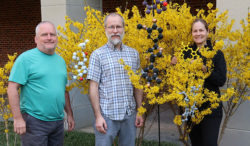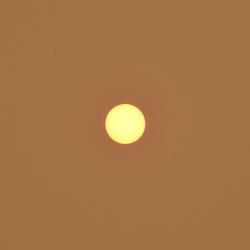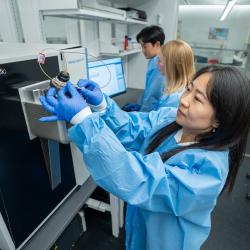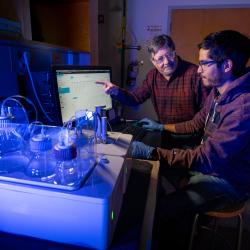Jeffery Davis—Making Organic Chemistry Tangible with Botany, Art and 3D Printing
Students transform the chemistry courtyard into a living classroom and sculpture garden.
University of Maryland Chemistry and Biochemistry Professor Jeffery Davis sees chemistry all around him. On a walk through campus, a river birch tree reminds him of the tumor-inhibiting betulinic acid it produces, and the striking purple berries of an American beautyberry call to mind the natural mosquito repellent in its leaves.

As an organic chemist who specializes in synthesizing compounds, Davis wants to inspire others to appreciate the chemistry surrounding us, especially in nature. That’s why he and two colleagues are turning the chemistry building’s courtyard garden into a walking introduction to the molecular world of plants. Their vision is a living classroom where 3D models of chemical compounds are artfully displayed beside the plants that produce them, along with signs and links to online information about their medicinal or nutritional uses.
“Nature is a chemistry synthesis lab right under our noses,” Davis said. “And when you get down to the molecular level, much of our natural world can be understood with chemistry.”
The project, called Chemistry in Our Garden, is a collaboration between Davis, Associate Professor of Chemistry and Biochemistry Paul Paukstelis and Adjunct Assistant Professor of Plant Science and Landscape Architecture Andrea Ottesen.
Davis got the idea for the project when he was preparing to teach the graduate class CHEM647: “Organic Synthesis” in the spring of 2020. He had just returned from Peru where he assisted Ottesen in teaching a study-abroad class called PLSC489: “Medicinal Plants of the Amazon.” Ottesen, who developed and taught the course for 10 years, invited Davis to provide a chemistry perspective.
“For the first time, I had a really awesome chemist on the trip,” said Ottesen, who is also the research area coordinator for metagenomics at the U.S. Food and Drug Administration’s Center for Food Safety and Applied Nutrition. She’s also a professional artist. “In the past, it’s been mostly botanists and ethnobotanists, and while we talk about chemical compounds in plants and what they do, we’ve never had anyone with us who really knew what that meant at a deeper, mechanistic level. Understanding these things at a molecular level was really exciting.”
For Davis, who grew up in a rural area and had always been impressed by his grandfather’s knowledge of forest plants and mushrooms, the trip reinvigorated his appreciation for the relationship between people and the natural world.
“Going to the Amazon and learning how people use these plants for food colorings and dyes for their clothing, and how much knowledge they have about natural medicines, I got very attracted to the ethno-botany aspect of natural products chemistry,” Davis said.
With the Peruvian experience fresh in his mind, Davis wanted to take a different approach to his organic chemistry class. Instead of having students memorize name reactions and reagents, Davis wanted them to understand how chemical compounds are isolated directly from the environment. He and Ottesen took the class on a tour of campus, pointing out plants and highlighting the various properties of their many natural products.
Then, each of the seven graduate students in the course identified two natural products from plants growing in the chemistry building’s courtyard garden, and Davis designed the course’s syllabus around studying both the biosyntheses and organic syntheses of the 14 natural products they selected.
For the class, the students researched the plants, the compounds they produce and their

medicinal or nutritional properties. They also studied how, when and why the plants produce the compounds, along with how to measure and extract the compounds.
Chemistry graduate student Solomon Kojo Attionu said making the connection between the chemical formulas and the real world outside the lab made the course material easier to understand and remember.
“Having an interactive class for organic is very helpful and being able to see how things at a microscopic level eventually manifest themselves in the physical world all around us is quite amazing,” Attionu said.
Just as Davis had hoped, the class also inspired some students to see the world from a new, chemistry-informed perspective.
“After touring the garden and the campus as part of Dr. Davis’ course, I was inspired to go around my house and look at the trees on my own,” said chemistry graduate student Mona Abdelrahman. “I noticed that the sweetgum fruits were similar in shape to coronaviruses, and I was astonished to learn that the tree contains shikimic acid.”
Shikimic acid is a precursor to the active ingredient in Tamiflu, a drug used to combat viruses such as influenza, which is shaped much like coronaviruses. Abdelrahman’s discovery sparked a conversation with Davis and Ottesen about the “doctrine of signatures,” a belief held in many forms of traditional medicine that posits a resemblance between a plant’s form and the ailment it cures.
After completing their research, Abdelrahman, Attionu and their classmates created presentations and worked with Davis and Ottesen to produce descriptions of their favorite plants and compounds for a public website.

The plan from there was for students to work with Paukstelis in the department’s 3D printing lab to create molecular sculptures of the compounds they studied. But the campus lockdown due to COVID-19 sidetracked that effort. The students were unable to work in the printing lab, and Paukstelis diverted much of his printing efforts into making personal protective equipment for hospital staff. Paukstelis has now printed five of the students’ compounds and created a sample wooden sign for one of the plants with the molecular formula and a QR code that links to the website the students created.
The team is still working out the details on how to display the 3D sculptures and signs permanently in the garden once they are all completed. In the meantime, COVID-19 provided Davis with an idea for expanding the project to undergraduates.
“Given the fact that COVID has really restricted the ability of undergraduates to find research opportunities in labs this fall, I thought it would be a good idea to offer some opportunities for creative students to get involved in this garden project,” he recounted.
Twenty students applied for what he envisioned as one or two research spots. In the end, he accepted four students—all chemistry or biochemistry majors—for fall 2020. Each student is learning about the chemistry and ethnobotany of two trees in the garden and creating 3D-printed molecular models for display.
“The students, Fiona, Joshua, Rebekah and Lucas, have already discovered so much interesting information that will help us design an impactful course,” Davis said.
Soon, Davis and his collaborators will have characterized 20 plants in the garden, and they are envisioning the next steps for the project.
“Andrea, Paul and I would like to ultimately develop a class, with both lecture and lab components, that would focus on the chemistry and ethnobotany of plant natural products from our garden,” Davis explained. “It could also serve as a teaching garden where we do community outreach and get younger students in K-12 interested in science, plants and chemistry. Also, Andrea is a world-class photographer and Paul is such a creative fellow, I really hope we can merge art with chemistry and hold exhibits in the adjacent atrium.”
Sharing the work broadly and stirring enthusiasm among as many people as possible is a goal that all three faculty members share. They are so committed to seeing others run with their ideas that they are putting the 3D models online for anyone to download and print on their own.
“It’s not just chemistry in our garden,” Paukstelis said. “It can be chemistry in your garden, too.”
###
Watch a video of Paukstelis in the garden with examples of the models here.
Written by Kimbra Cutlip






